Long-Term Prognosis of Febrile Individuals with Right Precordial Coved-Type ST-Segment Elevation Brugada Pattern: A 10-Year Prospective Follow-Up Study
Abstract
:1. Introduction
2. Methods
2.1. Study Population
2.2. Study Design and Ethical Considerations
2.3. Clinical Follow-Up
2.4. Statistical Analysis
3. Results
3.1. Clinical Characteristics of Patient Population
3.2. Effect of Fever on ECG Parameters
3.3. Follow-Up Data
Recurrence and Reversibility of Fever-Induced Brugada ECG Pattern
3.4. Long-Term Outcomes
4. Discussion
4.1. Recognition of Type 1 Brugada ECG Pattern in Febrile Subjects
4.2. Comparison with Previous Studies
4.3. Recurrence and Reversibility of Fever-Induced Brugada ECG Pattern
4.4. Study Limitations
5. Conclusions
Author Contributions
Funding
Institutional Review Board Statement
Informed Consent Statement
Data Availability Statement
Conflicts of Interest
References
- Brugada, P.; Brugada, J. Right bundle branch block, persistent ST segment elevation and sudden cardiac death: A distinct clinical and electrocardiographic syndrome: A multicenter report. J. Am. Coll. Cardiol. 1992, 20, 1391–1396. [Google Scholar] [CrossRef]
- Littmann, L.; Monroe, M.H.; Kerns, W.P., 2nd; Svenson, R.H.; Gallagher, J.J. Brugada syndrome and “Brugada sign”: Clinical spectrum with a guide for the clinician. Am. Heart J. 2003, 145, 768–778. [Google Scholar] [CrossRef]
- Antzelevitch, C.; Brugada, P.; Borggrefe, M.; Brugada, J.; Brugada, R.; Corrado, D.; Gussak, I.; LeMarec, H.; Nademanee, K.; Perez Riera, A.R.; et al. Brugada syndrome: Report of the second consensus conference: Endorsed by the Heart Rhythm Society and the European Heart Rhythm Association. Circulation 2005, 111, 659–670. [Google Scholar] [CrossRef] [PubMed] [Green Version]
- Junttila, M.J.; Gonzalez, M.; Lizotte, E.; Benito, B. Induced Brugada-type electrocardiogram, a sign for imminent malignant arrhythmia. Circulation 2008, 117, 1890–1893. [Google Scholar] [CrossRef] [PubMed] [Green Version]
- Postema, P.G.; Wolpert, C.; Amin, A.S.; Probst, V.; Borggrefe, M.; Roden, D.M.; Priori, S.G.; Tan, H.L.; Hiraoka, M.; Brugada, J.; et al. Drugs and Brugada syndrome patients: Review of the literature, recommendations, and an up-to-date website (www.brugadadrugs.com). Heart Rhythm 2009, 6, 1335–1341. [Google Scholar] [CrossRef] [Green Version]
- Tsai, C.F.; Wu, D.J.; Lin, M.C.; Ueng, K.C.; Lin, C.S. A Brugada-pattern electrocardiogram and thyrotoxic periodic paralysis. Ann. Intern. Med. 2010, 153, 848–849. [Google Scholar] [CrossRef] [Green Version]
- Amin, A.S.; Meregalli, P.G.; Bardai, A.; Wilde, A.A.M.; Tan, H.L. Fever increases the risk for cardiac arrest in the Brugada syndrome. Ann. Intern. Med. 2008, 149, 216–218. [Google Scholar] [CrossRef] [PubMed] [Green Version]
- Adler, A.; Topaz, G.; Heller, K.; Zeltser, D.; Ohayon, T.; Rozovski, U.; Halkin, A.; Rosso, R.; Ben-Shachar, S.; Antzelevitch, C.; et al. Fever-induced Brugada pattern: How common is it and what does it mean? Heart Rhythm 2013, 10, 1375–1382. [Google Scholar] [CrossRef] [Green Version]
- Priori, S.G.; Napolitano, C.; Gasparini, M.; Pappone, C.; Della Bella, P.; Giordano, U.; Bloise, R.; Giustetto, C.; De Nardis, R.; Grillo, M.; et al. Natural history of Brugada syndrome: Insights for risk stratification and management. Circulation 2002, 105, 1342–1347. [Google Scholar] [CrossRef] [Green Version]
- Delise, P.; Probst, V.; Allocca, G.; Sitta, N.; Sciarra, L.; Brugada, J.; Kamakura, S.; Takagi, M.; Giustetto, C.; Calo, L. Clinical outcome of patients with the Brugada type 1 electrocardiogram without prophylactic implantable cardioverter defibrillator in primary prevention: A cumulative analysis of seven large prospective studies. Europace 2018, 20, f77–f85. [Google Scholar] [CrossRef]
- Shimizu, W.; Antzelevitch, C.; Suyama, K.; Kurita, T.; Taguchi, A.; Aihara, N.; Takaki, H.; Sunagawa, K.; Kamakura, S. Effect of sodium channel blockers on ST segment, QRS duration, and corrected QT interval in patients with Brugada syndrome. J. Cardiovasc. Electrophysiol. 2000, 11, 1320–1329. [Google Scholar] [CrossRef] [PubMed]
- Tan, H.L.; Meregalli, P.G. Lethal ECG changes hidden by therapeutic hypothermia. Lancet 2007, 369, 78. [Google Scholar] [CrossRef]
- Kalra, S.; Iskandar, S.B.; Duggal, S.; Smalligan, R.D. Fever-induced ST-segment elevation with a Brugada syndrome type electrocardiogram. Ann. Intern. Med. 2008, 148, 82–84. [Google Scholar] [CrossRef]
- Alla, V.M.; Suryanarayana, P.G.; Kaushik, M. Temperature twist. Am. J. Med. 2010, 123, 127–130. [Google Scholar] [CrossRef] [PubMed]
- Abbas, H.; Roomi, S.; Ullah, W.; Ahmad, A.; Gajanan, G. Brugada pattern: A comprehensive review on the demographic and clinical spectrum. BMJ Case Rep. 2019, 12, e229829. [Google Scholar] [CrossRef] [PubMed]
- Ortega-Carnicer, J.; Benezet, J.; Ceres, F. Fever-induced ST-segment elevation and T-wave alternans in a patient with Brugada syndrome. Resuscitation 2003, 57, 315–317. [Google Scholar] [CrossRef]
- Dovgalyuka, J.; Holstege, C.; Mattu, A.; Brady, W.J. The electrocardiogram in the patient with syncope. Am. J. Emerg. Med. 2007, 25, 688–701. [Google Scholar] [CrossRef] [PubMed]
- Sharon, M.; Wilson, B.; End, B.; Kraft, C.; Minardi, J. Anterior ST-elevation in a patient with chest pain and fever. Ann. Emerg. Med. 2019, 74, 782–785. [Google Scholar] [CrossRef] [PubMed]
- Rattanawong, P.; Vutthikraivit, W.; Charoensri, A.; Jongraksak, T.; Prombandankul, A.; Kanjanahattakij, N.; Rungaramsin, S.; Wisaratapong, T.; Ngarmukos, T. Fever-induced Brugada syndrome is more common than previously suspected: A cross-sectional study from an endemic area. Ann. Noninvasive Electrocardiol. 2016, 21, 136–141. [Google Scholar] [CrossRef]
- Miyamoto, K.; Yokokawa, M.; Tanaka, K.; Nagai, T.; Okamura, H.; Noda, T.; Satomi, K.; Suyama, K.; Kurita, T.; Aihara, N.; et al. Diagnostic and prognostic value of a type 1 Brugada electrocardiogram at higher (third or second) V1 to V2 recording in men with Brugada syndrome. Am. J. Cardiol. 2007, 99, 53–57. [Google Scholar] [CrossRef] [PubMed]
- Erdogan, O.; Hunuk, B. Frequency of Brugada type ECG pattern in male subjects with fever. Int. J. Cardiol. 2013, 165, 562–563. [Google Scholar] [CrossRef] [PubMed]
- Giustetto, C.; Drago, S.; Demarchi, P.G.; Dalmasso, P.; Bianchi, F.; Masi, A.S.; Carvalho, P.; Occhetta, E.; Rossetti, G.; Riccardi, R.; et al. Risk stratification of the patients with Brugada type electrocardiogram: A community-based prospective study. Europace 2009, 11, 507–513. [Google Scholar] [CrossRef] [PubMed]
- Michowitz, Y.; Milman, A.; Sarquella-Brugada, G.; Andorin, A.; Champagne, J.; Postema, P.G.; Casado-Arroyo, R.; Leshem, E.; Juang, J.J.M.; Giustetto, C.; et al. Fever-related arrhythmic events in the multicenter survey on arrhythmic events in Brugada syndrome. Heart Rhythm 2018, 15, 1394–1401. [Google Scholar] [CrossRef]
- Mizusawa, Y.; Morita, H.; Adler, A.; Havakuk, O.; Thollet, A.; Maury, P.; Wang, D.W.; Hong, K.; Gandjbakhch, E.; Sacher, F.; et al. Prognostic significance of fever-induced Brugada syndrome. Heart Rhythm. 2016, 13, 1515–1520. [Google Scholar] [CrossRef]
- Wichter, T.; Matheja, P.; Eckardt, L.; Kies, P.; Schäfers, K.; Schulze-Bahr, E.; Haverkamp, W.; Borggrefe, M.; Schober, O.; Breithardt, G.; et al. Cardiac autonomic dysfunction in Brugada syndrome. Circulation 2002, 105, 702–706. [Google Scholar] [CrossRef] [Green Version]
- Makimoto, H.; Nakagawa, E.; Takaki, H.; Yamada, Y.; Okamura, H.; Noda, T.; Satomi, K.; Suyama, K.; Aihara, N.; Kurita, T.; et al. Augmented ST-segment elevation during recovery from exercise predicts cardiac events in patients with Brugada syndrome. J. Am. Coll. Cardiol. 2010, 56, 1576–1584. [Google Scholar] [CrossRef] [PubMed] [Green Version]
- Dumaine, R.; Towbin, J.A.; Brugada, P.; Vatta, M.; Nesterenko, D.V.; Nesterenko, V.V.; Brugada, J.; Brugada, R.; Antzelevitch, C. Ionic mechanisms responsible for the electrocardiographic phenotype of the Brugada syndrome are temperature dependent. Circ. Res. 1999, 85, 803–809. [Google Scholar] [CrossRef] [Green Version]
- Wilde, A.A.; Postema, P.G.; Di Diego, J.M.; Viskin, S.; Morita, H.; Fish, J.M.; Antzelevitch, C. The pathophysiological mechanism underlying Brugada syndrome: Depolarization versus repolarization. J. Mol. Cell. Cardiol. 2010, 49, 543–553. [Google Scholar] [CrossRef] [Green Version]
- Antzelevitch, C. The Brugada syndrome: Ionic basis and arrhythmia mechanisms. J. Cardiovasc. Electrophysiol. 2001, 12, 268–272. [Google Scholar] [CrossRef]
- Cerrone, M.; Lin, X.; Zhang, M.; Agullo-Pascual, E.; Pfenniger, A.; Chkourko Gusky, H.; Novelli, V.; Kim, C.; Tirasawadichai, T.; Judge, D.P.; et al. Missense mutations in plakophilin-2 cause sodium current deficit and associate with a Brugada syndrome phenotype. Circulation 2014, 129, 1092–1103. [Google Scholar] [CrossRef] [PubMed] [Green Version]
- Armaroli, A.; Balla, C.; Trabanelli, C.; Selvatici, R.; Brieda, A.; Sette, E.; Bertini, M.; Mele, D.; Biffi, M.; Campo, G.C.; et al. Lamin A/C missense mutation R216C pinpoints overlapping features between Brugada syndrome and laminopathies. Circ. Genom Precis Med. 2020, 13, e002751. [Google Scholar] [CrossRef] [PubMed]
- Scheirlynck, E.; Chivulescu, M.; Lie, Ø.H.; Motoc, A.; Koulalis, J.; de Asmundis, C.; Sieira, J.; Chierchia, G.B.; Brugada, P.; Cosyns, B.; et al. Worse prognosis in Brugada syndrome patients with arrhythmogenic cardiomyopathy features. JACC Clin. Electrophysiol. 2020, 6, 1353–1363. [Google Scholar] [CrossRef]
- Sacher, F.; Probst, V.; Iesaka, Y.; Jacon, P.; Laborderie, J.; Mizon-Gerard, F.; Mabo, P.; Reuter, S.; Lamaison, D.; Takahashi, Y.; et al. Outcome after implantation of a cardioverter-defibrillator in patients with Brugada syndrome: A multicenter study. Circulation 2006, 114, 2317–2324. [Google Scholar] [CrossRef] [Green Version]
- Probst, V.; Denjoy, I.; Meregalli, P.G.; Amirault, J.C.; Sacher, F.; Mansourati, J.; Babuty, D.; Villain, E.; Victor, J.; Schott, J.J.; et al. Clinical aspects and prognosis of Brugada syndrome in children. Circulation 2007, 115, 2042–2048. [Google Scholar] [CrossRef] [Green Version]
- Eckardt, L.; Probst, V.; Smiths, J.P.; Bahr, E.S.; Wolpert, C.; Schimpf, R.; Wichter, T.; Boisseau, P.; Heinecke, A.; Breithardt, G.; et al. Long-term prognosis of individuals with right precordial ST-segment-elevation Brugada syndrome. Circulation 2005, 111, 257–263. [Google Scholar] [CrossRef] [PubMed]
- Priori, S.G.; Gasparini, M.; Napolitano, C.; Della Bella, P.; Ottonelli, A.G.; Sassone, B.; Giordano, U.; Pappone, C.; Mascioli, G.; Rossetti, G.; et al. Risk stratification in Brugada syndrome: Results of the PRELUDE (PRogrammed ELectrical stimUlation preDictive valuE) registry. J. Am. Coll. Cardiol. 2012, 59, 37–45. [Google Scholar] [CrossRef] [PubMed] [Green Version]
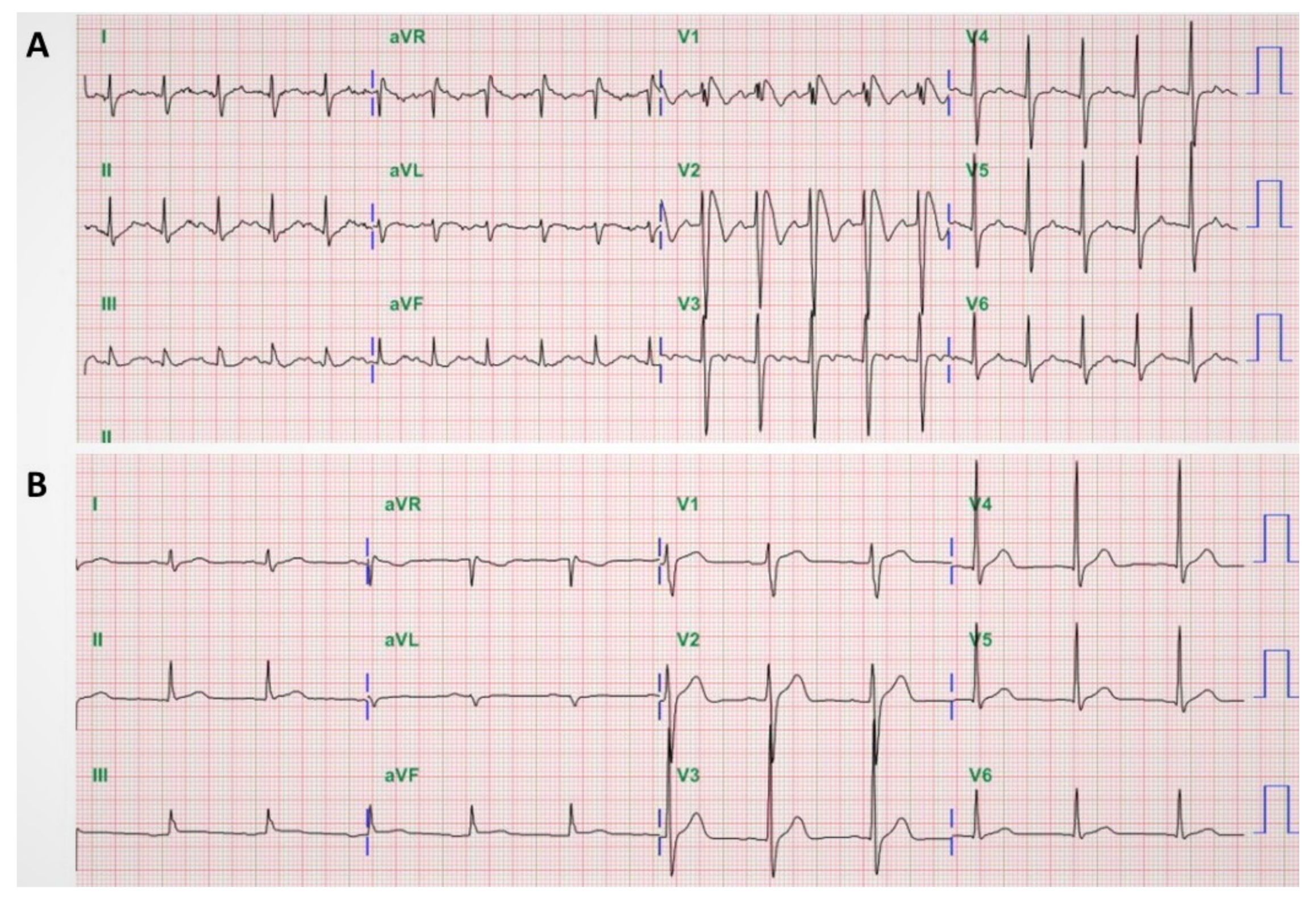
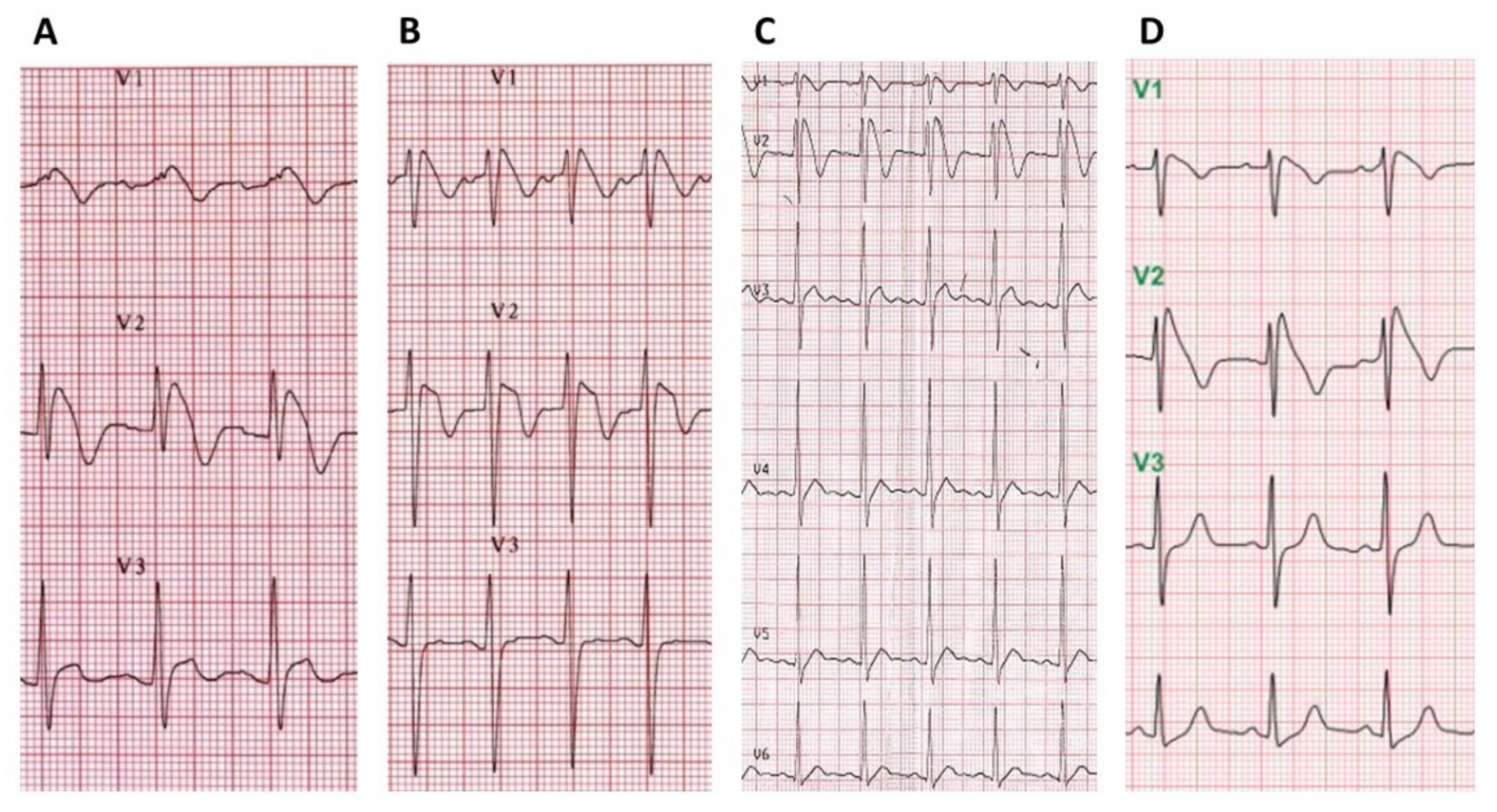
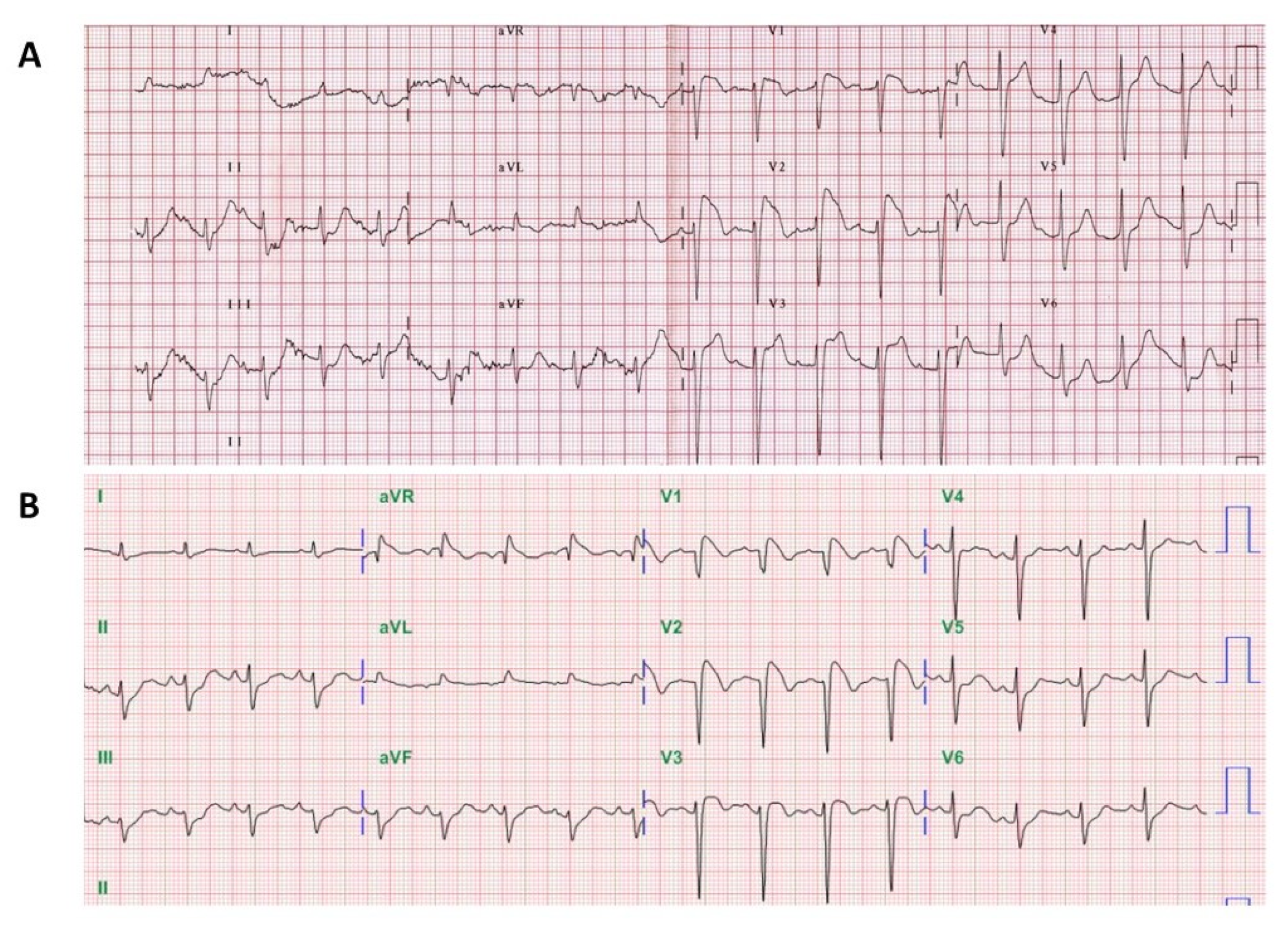
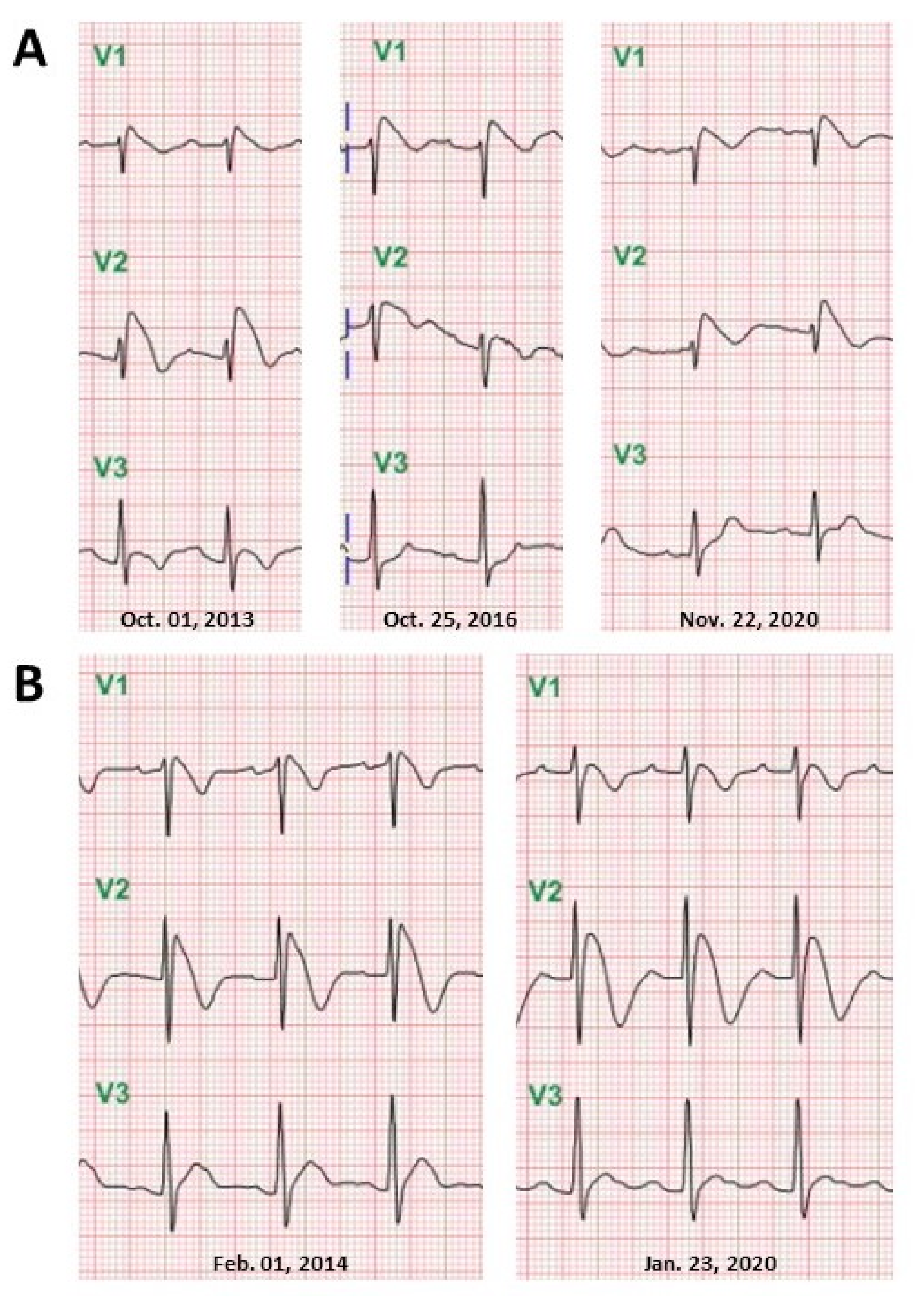
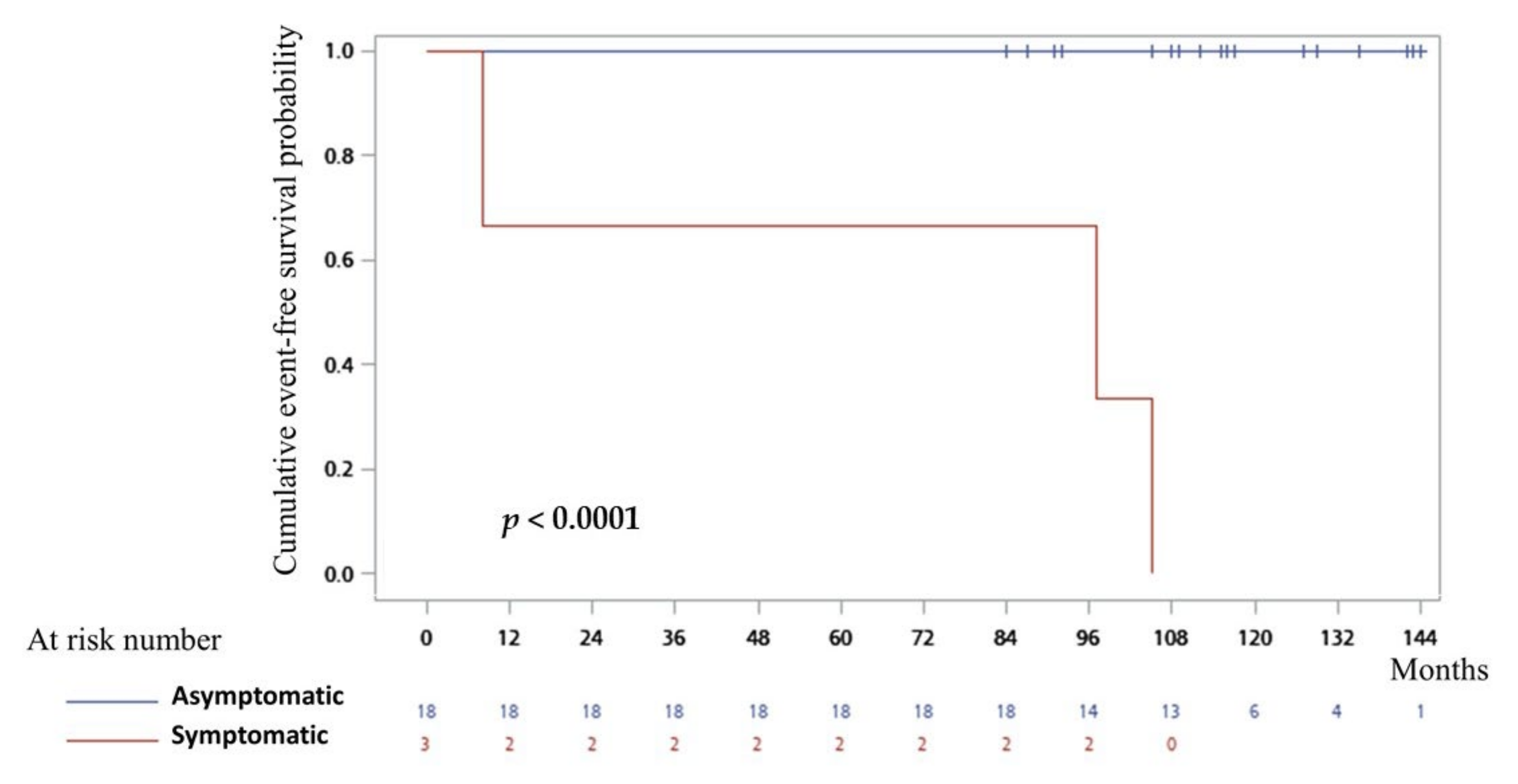
| Characteristics | Asymptomatic (n = 18) | Symptomatic (n = 3) | p |
|---|---|---|---|
| Gender | M (15)/F (3) | M (3) | |
| Age at diagnosis (yr) | 42 ± 18 | 55 ± 25 | 0.26 |
| Temperature (°C) | 38.8 ± 0.8 | 39.1 ± 0.6 | 0.54 |
| WBC (cells/mm3) | 12,908 ± 5046 | 14,113 ± 4503 | 0.70 |
| C-reactive protein (mg/dL) | 8.9 ± 8.4 | 13.5 ± 6.6 | 0.38 |
| Sodium (mmol/L) | 136 ± 3 | 137 ± 2 | 0.80 |
| Potassium (mmol/L) | 3.8 ± 0.4 | 3.7 ± 0.8 | 0.19 |
| Cardiac symptoms | None | Cardiac arrest (1) syncope (2) | |
| Programmed ventricular stimulation | NA (0/18) | Polymorphic VT (2/2) | |
| ICD therapy | None | Two |
| Variable | Asymptomatic (n = 18) | Symptomatic (n = 3) | p |
|---|---|---|---|
| HR febrile | 108 ± 20 | 105 ± 1 | 0.77 |
| HR afebrile | 77 ± 7 | 74 ± 4 | 0.41 |
| Δ HR | 31 ± 17 | 31 ± 3 | 0.99 |
| PR febrile | 159 ± 27 | 149 ± 6 | 0.52 |
| PR afebrile | 180 ± 21 | 165 ± 13 | 0.27 |
| Δ PR | −20 ± 23 | −18 ± 9 | 0.87 |
| QRSd febrile | 102 ± 11 | 107 ± 14 | 0.54 |
| QRSd afebrile | 97 ± 8 | 90 ± 8 | 0.21 |
| Δ QRSd | 5.8 ± 13 | 17 ± 14 | 0.18 |
| QTc febrile | 431 ± 42 | 453 ± 29 | 0.40 |
| QTc afebrile | 436 ± 40 | 426 ± 24 | 0.70 |
| Δ QTc | −4.6 ± 44.86 | 26.3 ± 12.7 | 0.26 |
Publisher’s Note: MDPI stays neutral with regard to jurisdictional claims in published maps and institutional affiliations. |
© 2021 by the authors. Licensee MDPI, Basel, Switzerland. This article is an open access article distributed under the terms and conditions of the Creative Commons Attribution (CC BY) license (https://creativecommons.org/licenses/by/4.0/).
Share and Cite
Tsai, C.-F.; Chuang, Y.-T.; Huang, J.-Y.; Ueng, K.-C. Long-Term Prognosis of Febrile Individuals with Right Precordial Coved-Type ST-Segment Elevation Brugada Pattern: A 10-Year Prospective Follow-Up Study. J. Clin. Med. 2021, 10, 4997. https://doi.org/10.3390/jcm10214997
Tsai C-F, Chuang Y-T, Huang J-Y, Ueng K-C. Long-Term Prognosis of Febrile Individuals with Right Precordial Coved-Type ST-Segment Elevation Brugada Pattern: A 10-Year Prospective Follow-Up Study. Journal of Clinical Medicine. 2021; 10(21):4997. https://doi.org/10.3390/jcm10214997
Chicago/Turabian StyleTsai, Chin-Feng, Yao-Tsung Chuang, Jing-Yang Huang, and Kwo-Chang Ueng. 2021. "Long-Term Prognosis of Febrile Individuals with Right Precordial Coved-Type ST-Segment Elevation Brugada Pattern: A 10-Year Prospective Follow-Up Study" Journal of Clinical Medicine 10, no. 21: 4997. https://doi.org/10.3390/jcm10214997
APA StyleTsai, C.-F., Chuang, Y.-T., Huang, J.-Y., & Ueng, K.-C. (2021). Long-Term Prognosis of Febrile Individuals with Right Precordial Coved-Type ST-Segment Elevation Brugada Pattern: A 10-Year Prospective Follow-Up Study. Journal of Clinical Medicine, 10(21), 4997. https://doi.org/10.3390/jcm10214997






